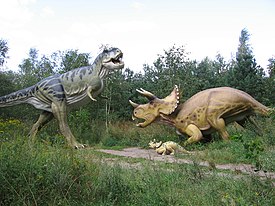

Cultural depictions of dinosaurs have been numerous since the word dinosaur was coined in 1842. The non-avian dinosaurs featured in books, films, television programs, artwork, and other media have been used for both education and entertainment. The depictions range from the realistic, as in the television documentaries from the 1990s into the first decades of the 21st century, to the fantastic, as in the monster movies of the 1950s and 1960s.
The growth in interest in dinosaurs since the Dinosaur Renaissance has been accompanied by depictions made by artists working with ideas at the forefront of dinosaur science, presenting lively dinosaurs and feathered dinosaurs as these concepts were first being considered. Cultural depictions of dinosaurs have been an important means of translating scientific discoveries to the public.
Cultural depictions have also created or reinforced misconceptions about dinosaurs and other prehistoric animals, such as inaccurately and anachronistically portraying a sort of "prehistoric world" where many kinds of extinct animals (from the Permian animal Dimetrodon to mammoths and cavemen) lived together, and dinosaurs lived lives of constant combat. Other misconceptions reinforced by cultural depictions came from a scientific consensus that has now been overturned, such as dinosaurs being slow and unintelligent, or the use of dinosaur to describe something that is maladapted or obsolete.
Depictions are necessarily conjectural, because petrification and other fossilization mechanisms do not preserve all details. Any reconstruction is thereby an artist's view that, in order to stay within the limits of the best knowledge at the time, must necessarily be inspired by other pictures already scientifically proved.